Shared Driving Assistance Design Considering Human Error Protection for Intelligent Electric Wheelchairs
Abstract
1. Introduction
2. System Overview
3. Design of the Obstacle Avoidance Controller
4. Design of Adaptive Shared Controller
4.1. Convex Set Stability Analysis
- As shown in Figure 5a, the state is stable if because any arbitrary control applied on the iE-Wheelchair is independent of causing collision with obstacles. Hence, the system is reliable and safe. Under such a scenario, is assigned to be 0, implying that the system is under is controlled completely by the user.
- As shown in Figure 5b, the condition where refers to the situation is when the valid input set from the robot involves the inputs from the user. Therefore, some inputs can be in both sets simultaneously, while others cannot. In actual operations, such a scenario implies that there exist obstacles in the environments and thus the iE-Wheelchair requires manual control to avoid collisions by tuning the value of control weight . From the viewpoint of the control theory, , and the proper value of lies within the inequality < < 1, where is the minimum of .
- When the valid input sets of the user and the robot intersect with each other, i.e., as well as , as shown in Figure 5c, this scenario is similar to the second condition, but it is more complicated in real environments. The stability range of is , where is the maximum of .
- The instability condition occurs if since no intersection appears in both sets, as shown in Figure 5d. In other words, there does not exist a valid control weight such that the iE-Wheelchair can be controlled properly. Such a scenario happens when the wheelchair moves very close to obstacles; therefore, the robot will immediately stop the wheelchair from moving further.
4.2. Algorithm of Deriving the Weight Adaptation
- Control weight of user-controlled input : the most stable status of the iE-Wheelchair is set to stationary without any control from the user. That is, when the velocity for moving straightforward and the angular velocity are zero, is assigned as 1. The higher the velocity, the more unsafe the system is. Therefore, as soon as the maximum value of and are reached, this control weight has to be set as zero. As illustrated in Figure 6a, the control weight is inversely and linearly proportional to the velocity. As a result, is defined as follows:where
- Control weight of the robot control input : The most stable state occurs when the velocity of moving straightforward and the angular velocity are zero, which implies that no obstacles appear in the surrounding environment of the iE-Wheelchair. In such a scenario, the weight control of the robot is assigned to be zero. On the other hand, when the maximum values of and are reached, implying that the obstacle is very closed to the robot, has to be 1. Similar to the weight control in the user input, Figure 6b presents the relationship between and the velocity as well as the angular velocity, where is linearly proportional to while inversely and linearly proportional to , respectively. As a result, is defined as follows:where
| Algorithm 1: Weight adaptation for the Human and the Robot Inputs |
| Input: : the rotational velocity of human control. : the translational velocity of human control. : the rotational velocity of robot control. : the translational velocity of robotic control. : the robot maximum translational velocity. : the robot maximum rotational velocity. : the weight of human control given by (35). : the weight of robot control given by (37). Output: : and are the translational and rotational velocity of the robot Optimal : the weight of shared control. Main:
|
4.3. Adaptive Shared Controller Design
5. Experiments
5.1. Design of Controller Parameters
- Auto mode: The whole system is performed autonomously, without any control by the user. Therefore, the iE-Wheelchair only moves forward and makes either left or right turns until the user terminates the system.
- Manual mode: No obstacle avoidance is provided by the system. Only when the iE-Wheelchair approaches the obstacles too closely does the shared control system immediately activate the emergency braking.
- Fixed Shared mode: The value of αs is set as the constant 0.5 in the experiments.
- Adaptive Shared mode: The values of weights are adaptively adjusted according to the environment.
5.2. Experimental Setup
- Skill-based error: skill-based error refers to the scenario in which the user is distracting when controlling the iE-Wheelchair. Thus, a delay of the operation control is likely to happen. In our experiments, the time delay is set to be 0.5 s for the manual operation of the user.
- Decision error: the miscarriage of orientation, regarded as the decision error, could be happened when the user operates the wheelchair towards walls or obstacles. Therefore, decision error is represented as the iE-Wheelchair is controlled by the user to approach the wall or obstacles.
- Over-speeding error: if the wheelchair is moving at a high speed, the risk of danger increases while causing injuries both for the user and the robot. Thus, it is essential to concern such a scenario in our experiments.
5.3. Evaluation Criterion
5.4. Test Results and Analysis
- Shared control with fixed weights gives better results over adaptive shared control when the iE-Wheelchair is controlled normally.
- However, when considering human errors, the proposed method has shown the effectiveness in terms of improving smoothness, fluency, and completion time, and also reducing user driving load while ensuring the stable and safe operation of the iE-Wheelchair.
6. Conclusions
Author Contributions
Funding
Data Availability Statement
Conflicts of Interest
References
- Liu, H.-D.; Gao, G.-J.; Lu, S.-D.; Hung, Y.-H. A novel LCOT control strategy for self-driving electric mobile robots. Energies 2022, 15, 9178. [Google Scholar] [CrossRef]
- Mihailidis, A.; Elinas, P.; Boger, J.; Hoey, J. An intelligent powered wheelchair to enable mobility of cognitively impaired older adults: An anticollision system. IEEE Trans. Neural Syst. Rehabil. 2007, 15, 136–143. [Google Scholar] [CrossRef] [PubMed]
- Pacchierotti, C. Cutaneous Haptic Feedback in Robotic Teleoperation; Springer: Berlin/Heidelberg, Germany, 2015. [Google Scholar]
- Jiang, S.-Y.; Lin, C.-Y.; Huang, K.-T.; Song, K.-T. Shared control design of a walking-assistant robot. IEEE Trans. Control Syst. Technol. 2017, 25, 2143–2150. [Google Scholar] [CrossRef]
- Janabi-Sharifi, F.; Hassanzadeh, I. Experimental analysis of mobile-robot teleoperation via shared impedance control. IEEE Trans. Syst. Man Cybern. Part B Cybern. 2011, 41, 591–606. [Google Scholar] [CrossRef] [PubMed]
- Faria, B.M.; Reis, L.P.; Lau, N. Adapted control methods for cerebral palsy users of an intelligent wheelchair. J. Intell. Robot. Syst. 2015, 77, 299–312. [Google Scholar] [CrossRef]
- Uratsuji, Y.; Takemurab, K.; Takamatsua, J.; Ogasawaraa, T. Mobility assistance system for an electric wheelchair using annotated maps. Adv. Robot. 2015, 29, 481–491. [Google Scholar] [CrossRef]
- Khademian, B.; Hashtrudi-Zaad, K. Dual-user teleoperation systems: New multilateral shared control architecture and kinesthetic performance measures. IEEE/ASME Trans. Mechatron. 2012, 17, 895–906. [Google Scholar] [CrossRef]
- Powell, D.; O’Malley, M. The task-dependent efficacy of shared control haptic guidance paradigms. IEEE Trans. Haptics 2012, 5, 208–219. [Google Scholar] [CrossRef]
- Song, K.T.; Jiang, S.Y.; Lin, M.H. Interactive teleoperation of a mobile manipulator using a shared-control approach. IEEE Trans. Hum. Mach. Syst. 2016, 46, 834–845. [Google Scholar] [CrossRef]
- Ezeh, C.; Trautman, P.; Devigne, L.; Bureau, V.; Babel, M.; Carlson, T. Probabilistic vs linear blending approaches to shared control for wheelchair driving. In Proceedings of the International Conference on Rehabilitation Robotics, London, UK, 17–20 July 2017; pp. 835–840. [Google Scholar]
- Hansson, A.; Servin, M. Semi-autonomous shared control of large-scale manipulator arms. Control Eng. Pract. 2010, 18, 1069–1076. [Google Scholar] [CrossRef]
- Urdiales, C.; Espejo, B.F.; Annicchiaricco, R.; Sandoval, F. Biometrically modulated collaborative control for an assistive wheelchair. IEEE Trans. Neural Syst. Rehabil. Eng. 2010, 18, 398–408. [Google Scholar] [CrossRef] [PubMed]
- Li, Q.; Chen, W.; Wang, J. Dynamic shared control for human-wheelchair cooperation. In Proceedings of the 2011 IEEE International Conference on Robotics and Automation, Shanghai, China, 9–13 May 2011; pp. 4278–4283. [Google Scholar]
- Urdiales, C.; Peula, J.M.; Fdez-Carmona, M.; Barrué, C.; Pérez, E.J.; Sánchez-Tato, I.; Toro, J.C.; Galluppi, F.; Cortés, U.; Annichiaricco, R.; et al. A new multi-criteria optimization strategy for shared control in wheelchair assisted navigation. Auton. Robots 2010, 30, 179–197. [Google Scholar] [CrossRef]
- Ton, C.; Kan, Z.; Mehta, S. Obstacle avoidance control of a human-in-the-loop mobile robot system using harmonic potential fields. Robotica 2018, 36, 463–483. [Google Scholar] [CrossRef]
- Xu, Q.; Ge, S. Adaptive control of human-interacted mobile robots with velocity constraint. In Proceedings of the 2018 International Conference on Social Robotics, Qingdao, China, 28–30 November 2018; pp. 390–399. [Google Scholar]
- Devigne, L.; Narayanan, V.-K.; Pasteau, F.; Babel, M. Low complex sensor-based shared control for power wheelchair navigation. In Proceedings of the 2016 IEEE/RSJ International Conference on Intelligent Robots and Systems, Daejeon, Republic of Korea, 9–14 October 2016; pp. 5434–5439. [Google Scholar]
- Devigne, L.; Pasteau, F.; Carlson, T.; Babel, M. A shared control solution for safe assisted power wheelchair navigation in an environment consisting of negative obstacles: A proof of concept. In Proceedings of the 2019 IEEE International Conference on Systems, Man, and Cybernetics, Bari, Italy, 6–9 October 2019; pp. 1043–1048. [Google Scholar]
- Ezeh, C.; Trautman, P.; Holloway, C.; Carlson, T. Comparing shared control approaches for alternative interfaces: A wheelchair simulator experiment. In Proceedings of the 2017 IEEE International Conference on Systems, Man, and Cybernetics, Banff, AB, Canada, 5–8 October 2017; pp. 93–98. [Google Scholar]
- Leaman, J.; La, H.-M. A Comprehensive Review of Smart Wheelchairs: Past, Present, and Future. IEEE Trans. Hum. Mach. Syst. 2017, 47, 486–489. [Google Scholar] [CrossRef]
- Kucukyilmaz, A.; Demiris, Y. Learning shared control by demonstration for personalized wheelchair assistance. IEEE Trans. Haptics 2018, 11, 431–442. [Google Scholar] [CrossRef] [PubMed]
- Soh, H.; Demiris, Y. Learning Assistance by demonstration: Smart mobility with shared control and paired haptic controllers. J. Hum. Robot. Interact. 2015, 4, 76–100. [Google Scholar] [CrossRef]
- Devigne, L.; Aggravi, M.; Bivaud, M.; Balix, N.; Teodorescu, S.; Carlson, T.; Spreters, T.; Pacchierotti, C.; Babel, M. Power wheelchair navigation assistance using wearable vibrotactile haptics. IEEE Trans. Haptics 2020, 1, 52–58. [Google Scholar] [CrossRef]
- Sheikh Sadi, M.; Alotaibi, M.; Islam, R.; Islam, S.; Alhmiedat, T.; Bassfar, Z. Finger-gesture controlled wheelchair with enabling IoT. Sensors 2022, 22, 8716. [Google Scholar] [CrossRef]
- Li, Z.; Zhao, S.; Duan, J.; Su, C.-Y.; Zhao, X. Human cooperative wheelchair with brain-machine interaction based on shared control strategy. IEEE/ASME Trans. Mechatron. 2016, 22, 185–195. [Google Scholar] [CrossRef]
- Yang, C.; Wu, H.; Li, Z.; He, W.; Wang, N.; Su, C.-Y. Mind control of a robotic arm with visual fusion technology. IEEE Trans. Ind. Inform. 2017, 14, 3822–3830. [Google Scholar] [CrossRef]
- Erdogan, A.; Argall, B.-D. Prediction of user preference over shared-control paradigms for a robotic wheelchair. In Proceedings of the 2017 International Conference on Rehabilitation Robotics, London, UK, 17–20 July 2017; pp. 1106–1111. [Google Scholar]
- Broad, A.; Murphey, T.; Argall, B. Highly parallelized data-driven MPC for minimal intervention shared control. arXiv 2019, arXiv:1906.02318. [Google Scholar]
- Erlien, S.-M.; Fujita, S.; Gerdes, J.-C. Shared steering control using safe envelopes for obstacle avoidance and vehicle stability. IEEE Trans. Intell. Transp. Syst. 2015, 17, 441–451. [Google Scholar] [CrossRef]
- Jiang, J.; Astolfi, A. State and output-feedback shared-control for a class of linear constrained systems. IEEE Trans. Autom. Control 2015, 61, 3209–3214. [Google Scholar] [CrossRef]
- Jiang, J.; Di Franco, P.; Astolfi, A. Shared control for the kinematic and dynamic models of a mobile robot. IEEE Trans. Control Syst. Technol. 2016, 24, 2112–2124. [Google Scholar] [CrossRef]
- Jiang, C.; Ni, B.; Han, X.; Tao, Y. Non-probabilistic convex model process: A new method of time-variant uncertainty analysis and its application to structural dynamic reliability problems. Comput. Methods Appl. Mech. Eng. 2014, 268, 656–676. [Google Scholar] [CrossRef]
- Wang, L.; Wang, X.; Xu, D.; Zhang, X. Non-probabilistic time-variant reliability assessment (NTRA) for the active control of vibration systems with convex uncertainties. ISA Trans. 2018, 83, 276–289. [Google Scholar] [CrossRef] [PubMed]
- Wang, H.; Liu, X.P. Adaptive shared control for a novel mobile assistive robot. IEEE/ASME Trans. Mechatron. 2014, 19, 1725–1736. [Google Scholar] [CrossRef]
- FAA. Human Factors Analysis and Classification System; Federal Aviation Administration: Washington, DC, USA, 2000.
- Uchiyama, N.; Hashimoto, T.; Sano, S.; Takagi, S. Model-reference control approach to obstacle avoidance for a human-operated mobile robot. IEEE Trans. Ind. Electron. 2009, 56, 3892–3896. [Google Scholar] [CrossRef]
- Gantmacher, F.R. The Theory of Matrices; Chelsea Publishing Company: New York, NY, USA, 1959; Volume 2. [Google Scholar]
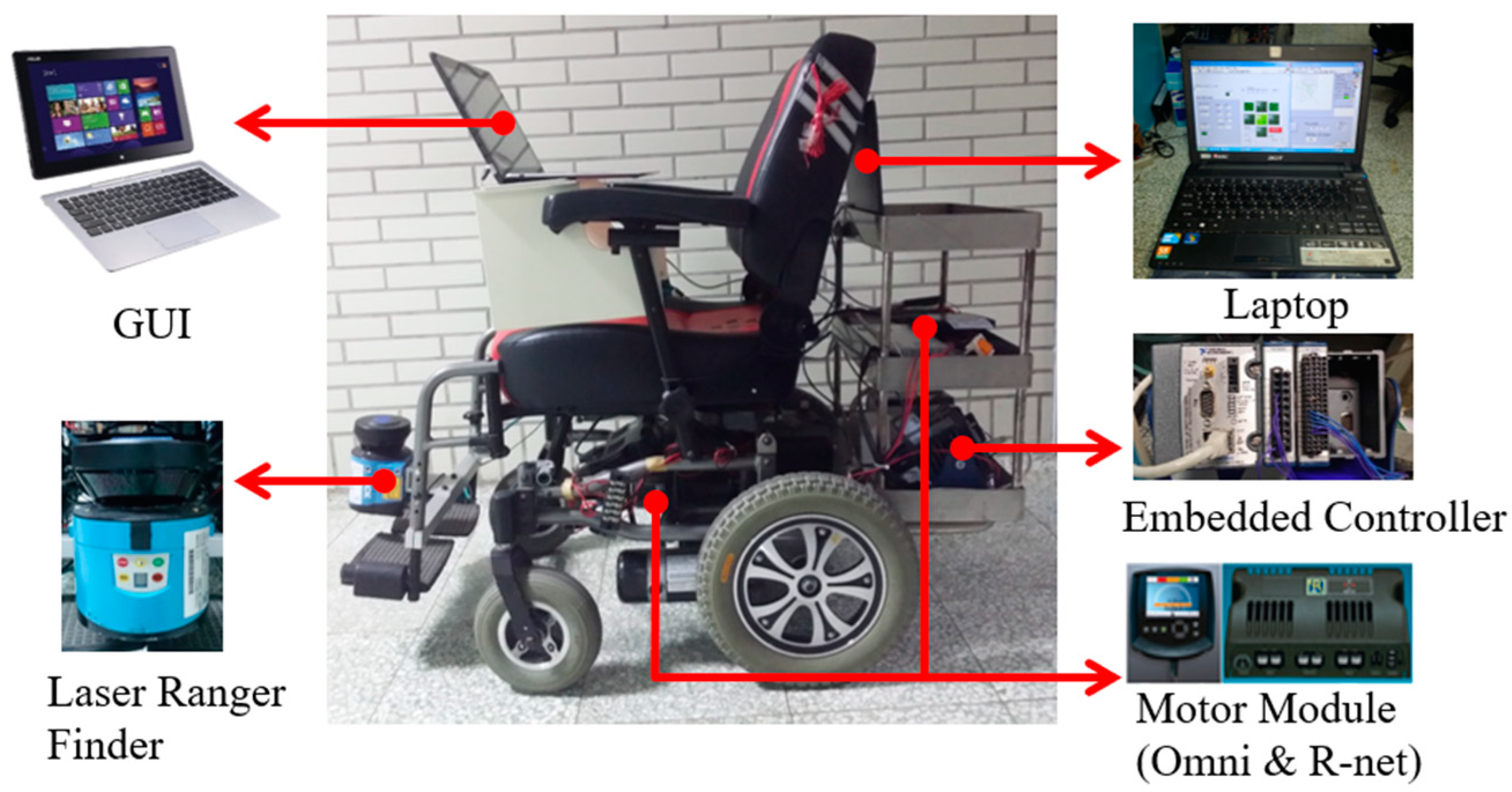

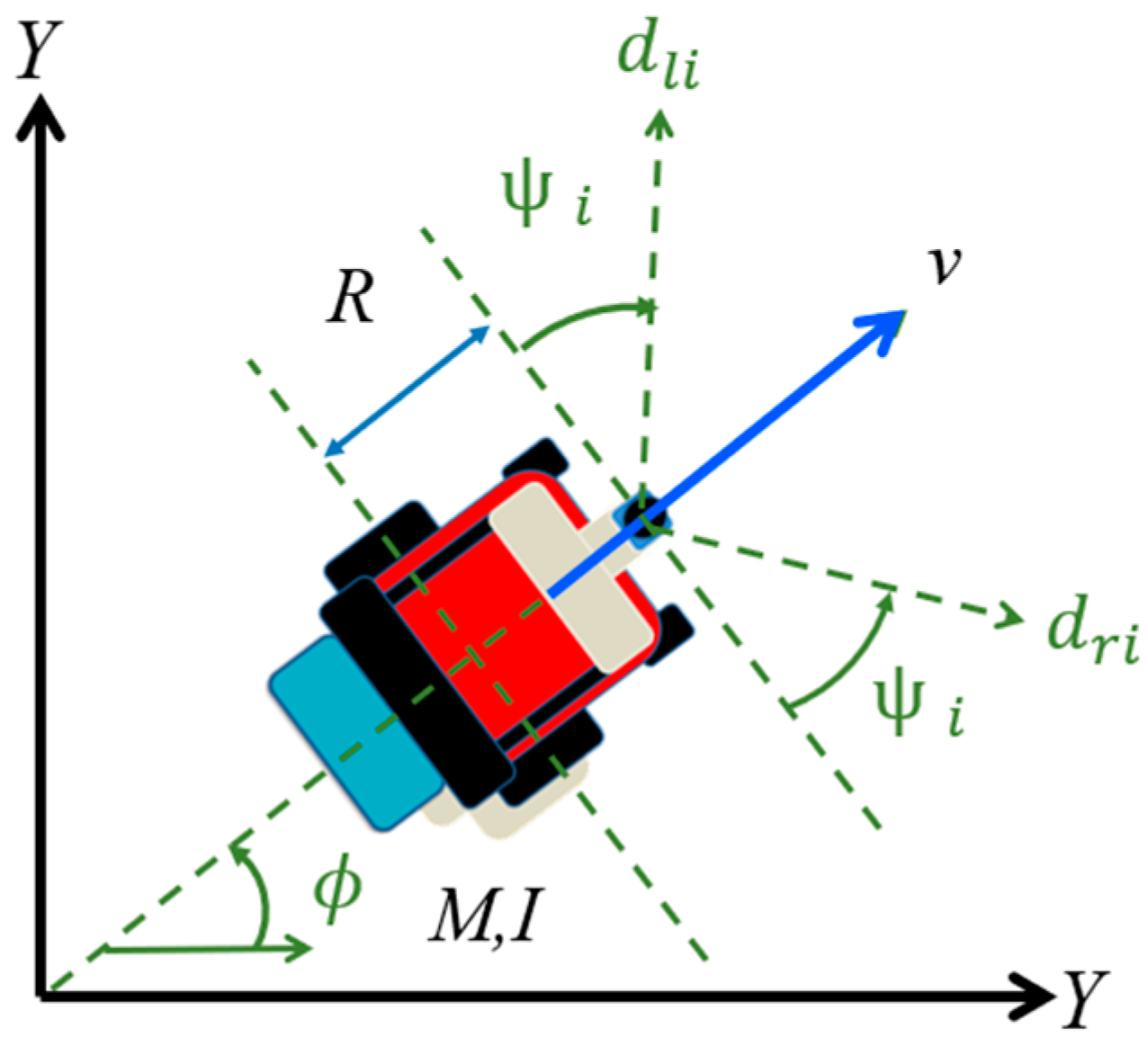

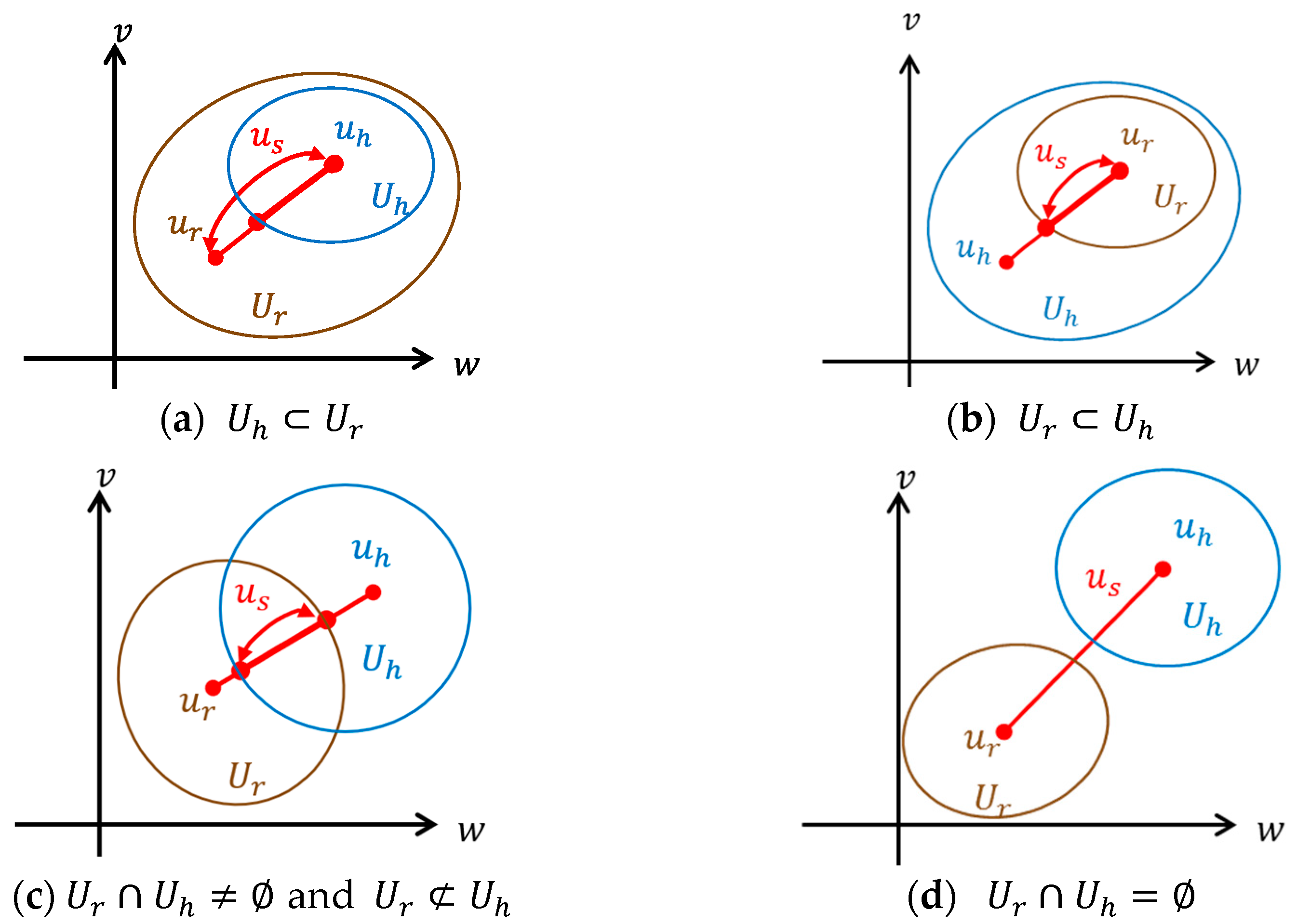
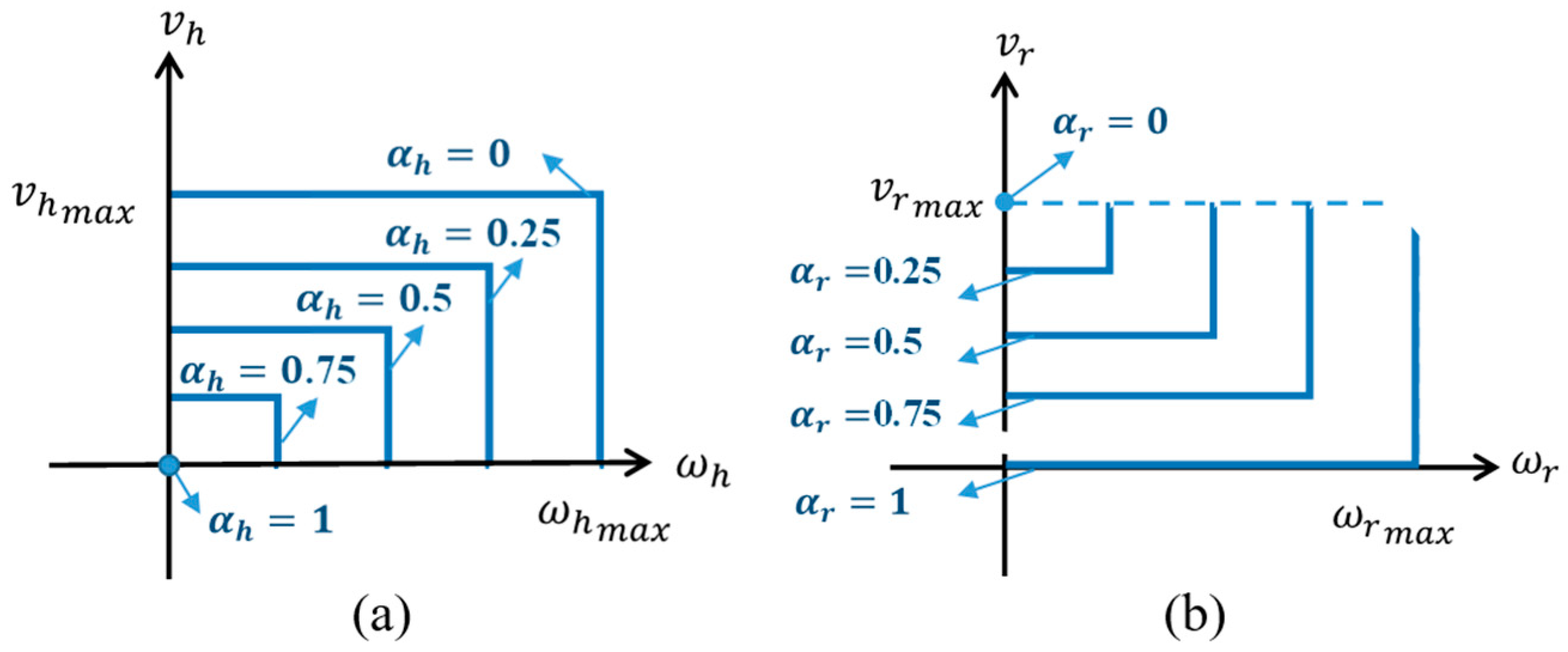

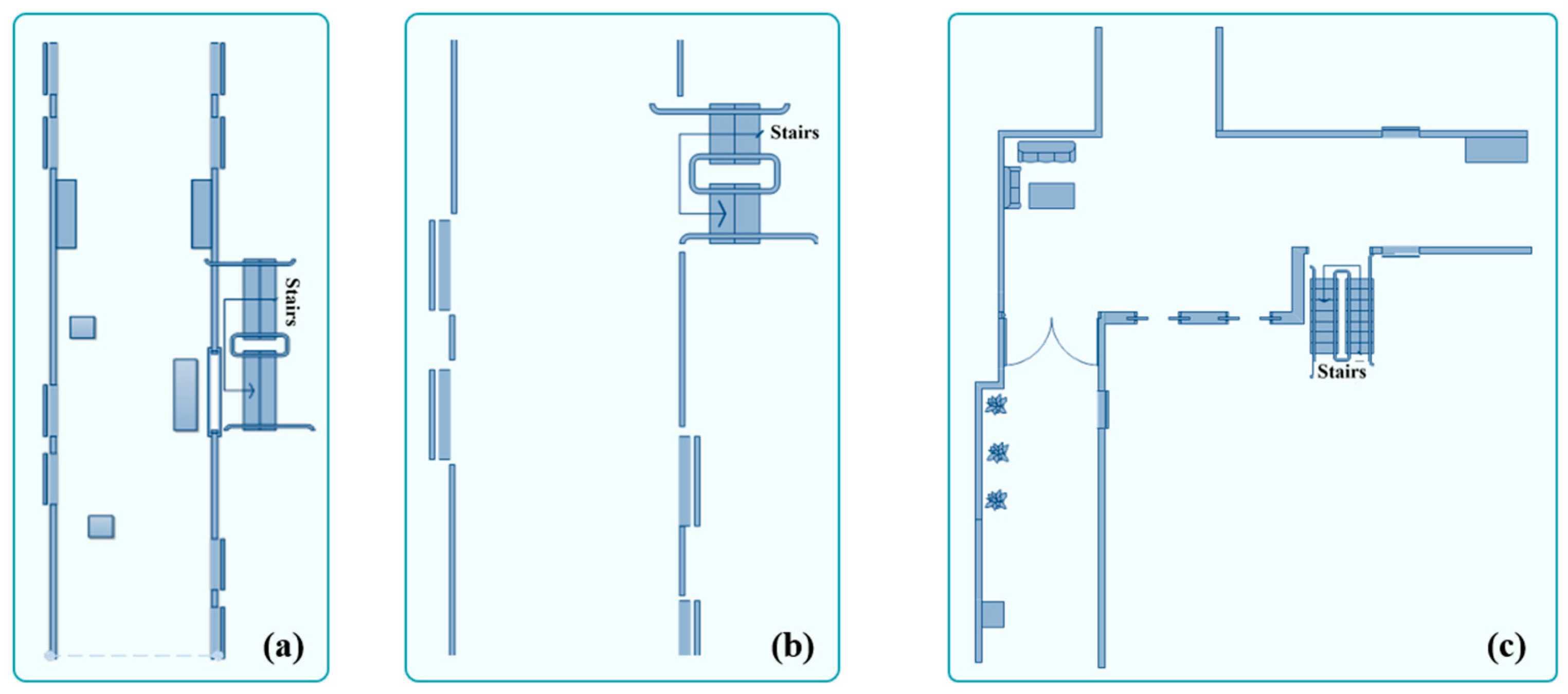




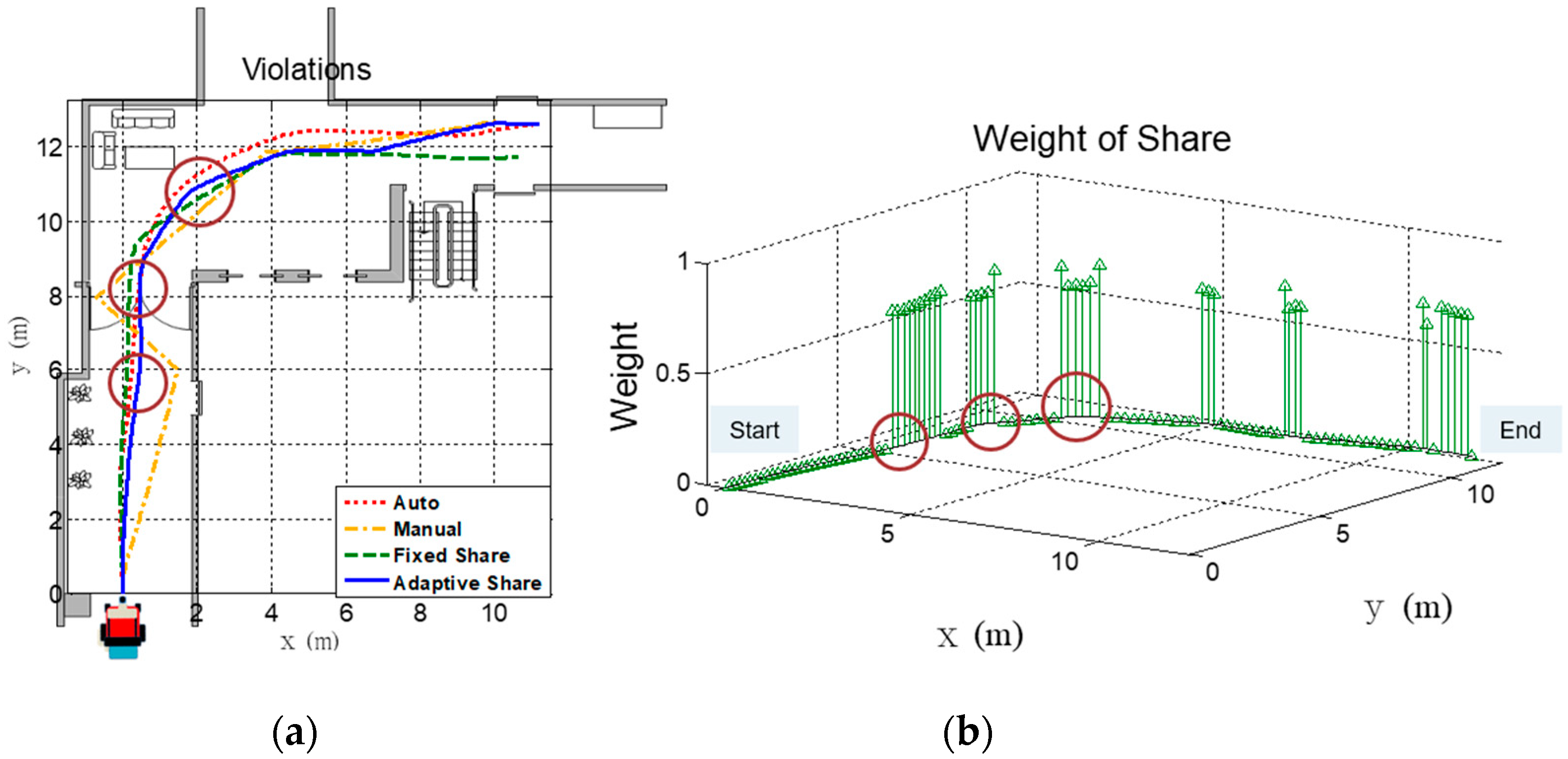

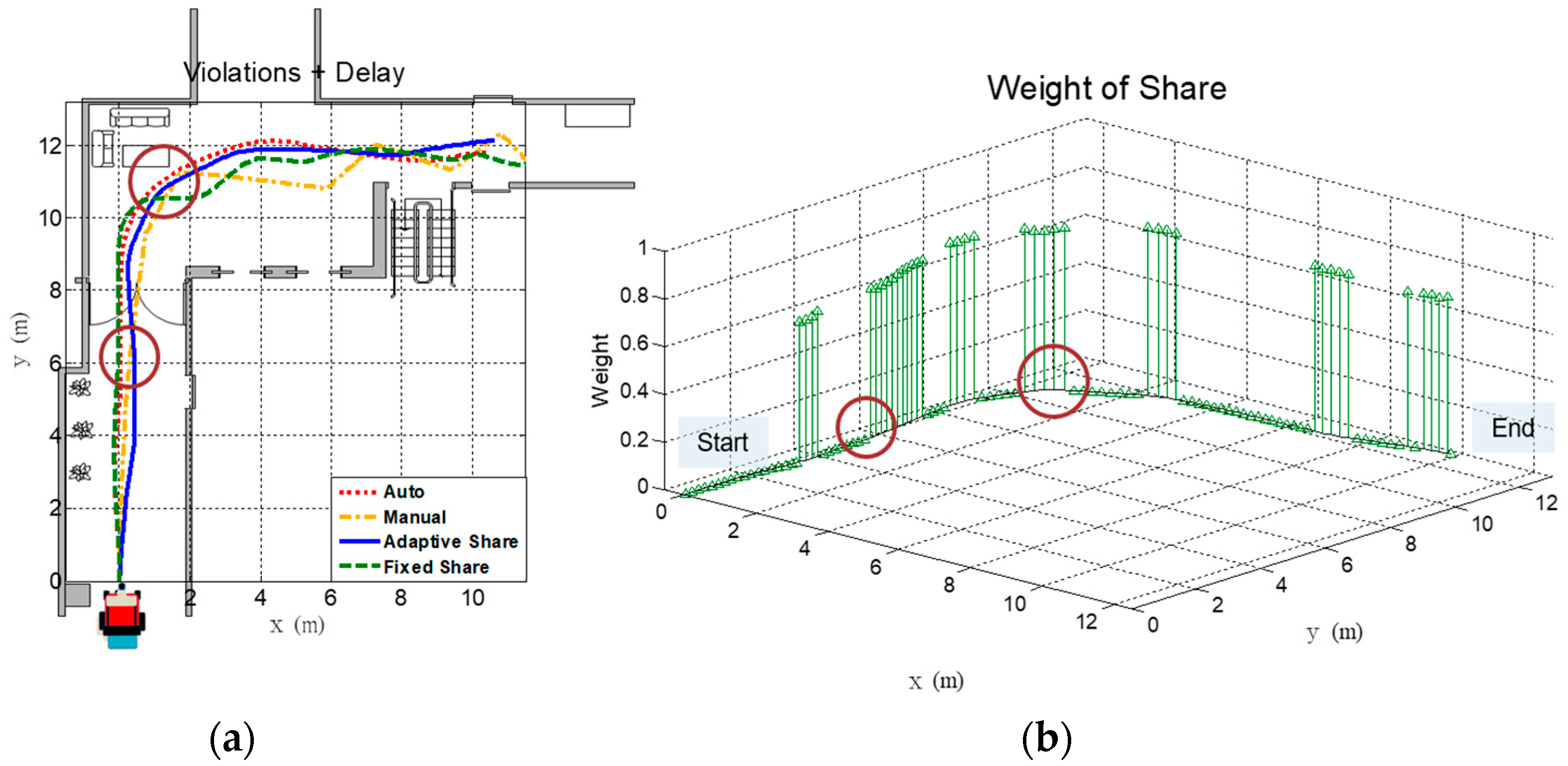

| M | 165 [kg] | I | 49.91 [kg∙m2] |
| ν0 | 1.67 [m/s] | R | 0.55 [m] |
| Rc | 0.75 [m] | r | 0.6 [m] |
| αi | 2000 | βi | 160 |
| Cν | 450 [Nm/s] | Cϕ | [Nm/(rad/s)] |
Disclaimer/Publisher’s Note: The statements, opinions and data contained in all publications are solely those of the individual author(s) and contributor(s) and not of MDPI and/or the editor(s). MDPI and/or the editor(s) disclaim responsibility for any injury to people or property resulting from any ideas, methods, instructions or products referred to in the content. |
© 2023 by the authors. Licensee MDPI, Basel, Switzerland. This article is an open access article distributed under the terms and conditions of the Creative Commons Attribution (CC BY) license (https://creativecommons.org/licenses/by/4.0/).
Share and Cite
Chiang, H.-H.; You, W.-T.; Lee, J.-S. Shared Driving Assistance Design Considering Human Error Protection for Intelligent Electric Wheelchairs. Energies 2023, 16, 2583. https://doi.org/10.3390/en16062583
Chiang H-H, You W-T, Lee J-S. Shared Driving Assistance Design Considering Human Error Protection for Intelligent Electric Wheelchairs. Energies. 2023; 16(6):2583. https://doi.org/10.3390/en16062583
Chicago/Turabian StyleChiang, Hsin-Han, Wan-Ting You, and Jin-Shyan Lee. 2023. "Shared Driving Assistance Design Considering Human Error Protection for Intelligent Electric Wheelchairs" Energies 16, no. 6: 2583. https://doi.org/10.3390/en16062583
APA StyleChiang, H.-H., You, W.-T., & Lee, J.-S. (2023). Shared Driving Assistance Design Considering Human Error Protection for Intelligent Electric Wheelchairs. Energies, 16(6), 2583. https://doi.org/10.3390/en16062583






